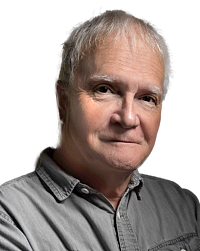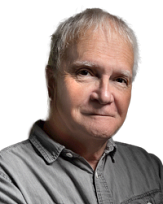Copyright © Wolverhampton Photographic Society 2025
No image or design on this site may be copied or used in printed or digital form without permission
and all photographs remain the property and copyright of the original photographer.
I must have been about ten when my parents gave me a little camera to try,
loaded with a black & white 12 exposure film. They showed me how to use it and
I went into the garden to try it out, but having taken seven or eight snaps of
anything I could find I suddenly remembered I’d been told to turn the dial to
move the film ready for the next photo. Realising my
error I quickly turned the dial to make up for the
shots I had taken then went on to finish the film.
When eventually we all looked at the photos my
parents couldn’t understand why most of the film
was blank and one shot was unrecognisable … but I
did!
Maybe it was that first experience which ignited my
interest in photography, or perhaps it was simply my
parents giving me an opportunity to have a go at
such an early age, but from then on I wanted to take
pictures. The camera they gave me was a box
camera with two lenses - one for the viewfinder and
one for the film - and you looked down into a window on the top. A few years
later, when I was at secondary school, I was lucky enough to be given my first
proper film camera when a
friend of my mother was
buying a new one. It was a
Halina 35X camera and it had
a case, a separate light meter
and a flash gun you could
attach which used blue
coloured bulbs. I felt I was so
posh but learned a huge
amount by using that setup.
My first digital camera was
the 3.1Mpixel Canon EOS D30
though now I use a 45Mpixel
full-frame Canon EOS R5 mirror-less camera and am
not sure I would want to go back to a DSLR. I
absolutely love this camera and already I’ve had
great adventures with it. How times have changed
since I used that box camera in the garden as a
child.
I am a landscape photographer by choice, whether
that is daytime or at night and I am so much
enjoying doing landscape astrophotography with my
friends from WPS. It is the challenge of working in
the dark, I think, or maybe it is just being out
under the stars.
Though I’ve mentioned the camera I use,
photography is not about the brand you use because
you can get great results using any of the modern
cameras. The important thing is to concentrate on
the type of photography that inspires you and that
you strive to become better and better at what you
create.
Here are a few things I believe have had a massive
impact on changing my images from straightforward
snaps to photographs I can be proud of:
•
Joining a photographic group like WPS: you
may not like what the judges say about your
work but on the whole you learn a lot about
what makes a good photograph. You get
comments from fellow members too and see
a range of work and some inspires you. You
also make new friends which has been great.
•
Using a full-frame sensor camera: you don’t
need one of these to get stunning
photographs, though they do make a
difference to be sure, but for me it was a
game changer. When I strained to purchase a
Canon 5D Mk II I think the expense of doing
that somehow jolted me to thinking I’d better
try harder or else that’s a whole load of
money down the drain. Sounds silly, but I do
wonder if that was the psychology involved.
Who knows!
•
Using YouTube to learn more: I discovered
photographers such as Thomas Heaton, Nigel
Danson and Alyn Wallace and they have been
a huge inspiration to me, changing the way I
think about and use my camera and the
photographs I capture. I subscribe to their
channels and also to those of one or two
other landscape photographers. There’s
undoubtedly also a channel for your
photographic interests, so get searching.
The best thing to do of course is to get out there and do whatever type of
photography inspires you. Remember though, that whatever you do or however
you do it, have fun!
Wolverhampton
Photographic
Society
Members’
Galleries

Click on a photo to view it
larger and see a slide-show
of the images on this page
Disko Bay at Midnight


Ait Benhaddou, Morocco
Forever Watching
Jokulsarlon Aurora
Vestrahorn at Midnight
Stiperstones Eruption
Talacre Lighthouse
Sunset at Nipstone Rock
Kirkufell
Photographs on this page
are Copyright © Rob Cowell
Heading Home












Copyright © Wolverhampton Photographic Society 2025
No image or design on this site may be copied or used in printed form or digitally without permission
and all photographs remain the property and copyright of the original photographer.
I must have been about
ten when my parents
gave me a little camera
to try, loaded with a
black & white 12
exposure film. They
showed me how to use
it and I went into the
garden to try it out, but
having taken seven or
eight snaps of anything I could
find I suddenly remembered
I’d been told to turn the dial
to move the film ready for the
next photo. Realising my error
I quickly turned the dial to
make up for the shots I had
taken then went on to finish
the film. When eventually we
all looked at the photos my parents
couldn’t understand why most of the film
was blank and one shot was unrecognisable … but I
did!
Maybe it was that
first experience
which ignited my
interest in
photography, or
perhaps it was
simply my parents
giving me an
opportunity to have
a go at such an early
age, but from
then on I wanted
to take pictures.
The camera they
gave me was a
box camera with
two lenses - one
for the viewfinder
and one for the
film - and you
looked down into a window on
the top. A few years later, when I
was at secondary school, I was
lucky enough to be given my first
proper film camera when a
friend of my mother was buying a
new one. It was a Halina 35X
camera and it had a case, a
separate light meter and a flash
gun you could attach which used
blue coloured bulbs. I felt I was
so posh but learned a huge
amount by using that setup.
My first digital camera was the
3.1Mpixel Canon EOS D30 though
now I use a 45Mpixel full-frame
Canon EOS R5 mirror-less camera
and am not sure I would want to
go back to a DSLR. I absolutely
love this camera and already I’ve had great adventures with it. How
times have changed since I used that box camera in the garden as a
child.
I am a landscape photographer by choice, whether that is daytime or
at night and I am so much enjoying doing landscape astrophotography
with my friends from WPS. It is the challenge of working in the dark, I
think, or maybe it is just being out under the stars.
Though I’ve mentioned the camera I use, photography is not about
the brand you use because you can get great results using any of the
modern cameras. The important thing is to concentrate on the type
of photography that inspires you and that you strive to become better
and better at what you create.
Here are a few things I believe
have had a massive impact on
changing my images from
straightforward snaps to
photographs I can be proud of:
•
Joining a photographic
group like WPS: you may
not like what the judges
say about your work but on
the whole you learn a lot
about what makes a good
photograph. You get
comments from fellow
members too and see a
range of work and some
inspires you. You also make
new friends which has
been great.
•
Using a full-frame sensor camera: you don’t need one of these
to get stunning photographs, though they do make a difference
to be sure, but for me it was a game changer. When I strained
to purchase a Canon 5D Mk II I think the expense of doing that
somehow jolted me to thinking I’d better try harder or else
that’s a whole load of money down the drain. Sounds silly, but I
do wonder if that was the psychology involved. Who knows!
•
Using YouTube to learn more: I discovered photographers such
as Thomas Heaton, Nigel Danson and Alyn Wallace and they
have been a huge inspiration to me, changing the way I think
about and use my camera and the photographs I capture. I
subscribe to their channels and also to those of one or two
other landscape photographers. There’s undoubtedly also a
channel for your photographic interests, so get searching.
The best thing to do of course is to get out there and do whatever
type of photography inspires you. Remember though, that whatever
you do or however you do it, have fun!



Photographs on this page
are Copyright © Rob Cowell
Click on a photo to view it
larger and see a slide-show
of the images on this page
Disko Bay at Midnight
Talacre Lighthouse
Sunset at Nipstone Rock
Heading Home
Vestrahorn at Midnight
Stiperstones Eruption











Kirkufell
Ait Benhaddou, Morocco
Jokulsarlon Aurora
Forever Watching























